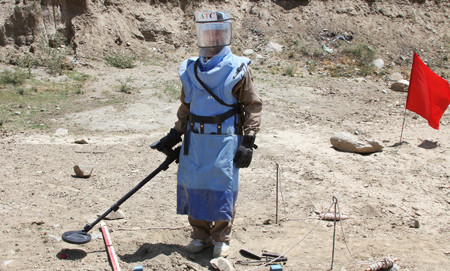NPR, July 17, 2012
Old Mines Bring New Casualties In Afghanistan
By Sean Carberry
Windblown villages of mud houses surround the huge Bagram Airfield north of Kabul. These poor villagers make a living in ways that can also kill them: They graze their animals or forage for scrap metal — often on a NATO firing range.
The East River Range dates to the 1980s, when the Soviet army occupied Afghanistan. It's full of mines, grenades and other ordnance that should have detonated during training exercises over the years. It sprawls along a mountainside and grazing areas. It's poorly marked, and only small sections are clearly identified by signs and concrete barriers.
A couple of months ago, 16-year-old Abdul Rahman was picking up scraps of metal like a lot of kids do in the village. He picked up something he didn't recognize; it turned out to be a grenade. It blew off both his arms, making him one of 15 reported casualties on the range over the last few years.
Abdul says he wasn't aware of the danger of the range nor of the grenade. If he had known, he says, "I wouldn't have touched it for a million dollars."
While grazing his sheep one night, Abdul's father, Zergul, lost part of his leg when he stepped on something that exploded. He says that in the dark, he couldn't tell where the range was. What's more tragic and vexing is that he didn't warn his son even after the incident.
A Legacy Of War
After decades of war, Afghanistan is littered with land mines and unexploded ordnance. In the last two years, more than 1,000 people have been killed or injured by so-called unexploded remnants of war.

A de-mining expert demonstrates how to find land mines in a training area near Hakim Village in central Afghanistan, where Soviet mines dating to the 1980s are still a danger. (Photo: Sean Carberry/NPR)
Protecting Afghans from the dangers isn't just about cordoning off or clearing areas, it's also about trying to educate them.
The Afghan-run Mine Action Coordination Center of Afghanistan coordinates all the de-mining activities in the country. Mohammed Sediq Rashid, its chief of operations, says the main reason behind these incidents is economics.
"We are constantly trying to work on this challenge, how to change the behavior of people," he says.
Mine Action has been doing awareness and removal work in Afghanistan since 1989. It oversees 13,000 people working to clear the country of mines and ordnance.
Rashid says NATO is taking more steps to alert the locals and keep them out of the East River range, but even fencing it off completely wouldn't stop people from taking chances. Particularly challenging is protecting children, who are often curious and unaware.
"When they find something unusual, they are playing with it, and they are playing with it together in groups," Rashid says.
That's why children make up the majority of casualties from unexploded ordnance, or UXO. And, while tragic and seemingly preventable, incidents at the range cause only a small fraction of the casualties each year.
About two-thirds of the UXO dates from the Soviet occupation of the 1980s. But the war between allied NATO and Afghan forces and the insurgents is leaving plenty behind as well. Rashid says NATO is not adequately considering unexploded ordnance that will be left behind when the war is over.
NATO says it does what is feasible within security constraints. Mine Action wants more coordination from NATO and wants to know sooner about incidents that might have left fresh UXO.
Spotting Mines
Mirwais Hussaini, who also works for Mine Action, visits a clearing operation in Hakim Village, north of Kabul. There hasn't been any fighting here for more than a decade, though several people are injured each year by mines dating back to the Soviet era.
A man covered in body armor uses a metal detector to demonstrate how he identifies a potential mine. Behind him, a clearing team is slowly working its way up a mountainside in the scorching sun.
Nearby, a group of villagers is asking to be trained to clear mines. One man lost his leg on the hillside six years ago. Another man, who was a fighter, says he planted many of the mines. Now, he wants to help remove them.
In this village, mine awareness seems to have taken hold; the people generally avoid the hills that are still mined and stick to the areas Mine Action has cleared. One man says he has stopped women from gathering firewood in the hills because of the danger.
Hussaini says that whenever there is a report of new fighting in a particular area, a mine risk education team is dispatched to the scene. He says members tell residents to avoid the contaminated areas and especially to keep their children away from the danger. He says that's the immediate solution.
Because of security issues and limited resources, it can take months before Mine Action can actually start clearing away new unexploded ordnance. And it could take a decade or more to rid the country of these deadly remnants.
NPR's Hashmat Baktash contributed to this report.
Characters Count: 6050
